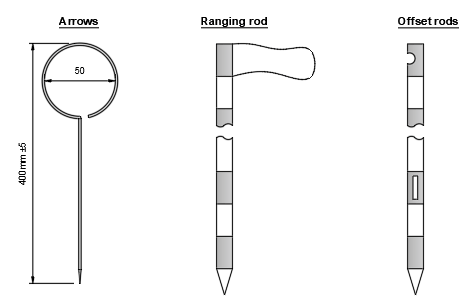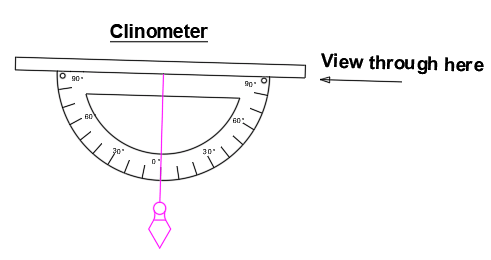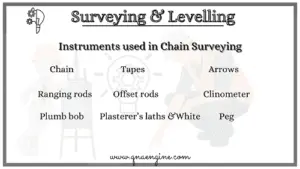What are the instruments used in chain surveying?
There are various types of instruments used in chain surveying for measuring linear measurements on the ground. The instruments used in chaining in surveying are as follows:
- Chain
- Tapes
- Arrows
- Ranging rods
- Offset rods
- Peg
- Plumb bob
- Plasterer’s laths
- White
- Clinometer
What is a chain in surveying?
Chains are the main instruments used in chain surveying. The chains are generally formed with galvanized mild-steel wire. In general, there are five types of chains are used in surveying.
- Metric chain-These chains are either 20m or 30 m in length. In a 20m chain, 100 links are there, and in a 30 m chain 150 links. Each link of these chains is 0.2 m in length. The metric chain is manufactured of galvanized mild-steel wire 4 mm in diameter. For easy reading of measurements, tallies are provided in the chain at an interval of 5 m.
- Surveyors chain or Gunter’s chain- A gunter’s chain is 66 ft long. It consists of 100 links, each link of length 0.06 ft or 7.92 inches. The chain was adopted as a surveyor’s chain because of its convenience in land measurement. (a) 10 square gunter’s chain= 1 acre. (b) 10 square gunter’s chain = 1 furlong (c) 80 square gunter’s chain = 1 mile.
- Engineers chain -The engineer’s chain is 100 ft in length and divided into 100 links. The length of each link is 1 ft. This chain is used on engineering surveys.
- Revenue Chain- The revenue chain is 33 ft in length and divides into 16 equal links.
- Band chain or steel band- The steel band is of length 20 or 30m. One side of this chain is graduated in meter, decimetre, and centimeter and the other side divided into 0.2 m links.
Uses: The chains are the primary instruments used in chain surveying for measuring the horizontal distances along the ground.
Tapes
Among the instruments used in chain surveying for measuring distance, tapes are more accurate than chains. Tapes are manufactured of various materials. Tapes are classified into four types.
- Linen or cloth tape
- Metallic tape
- Steel tape
- Invar tape
Uses: The tapes are the instruments used in chain surveying for achieving higher accuracy (than a chain) in measuring the horizontal distances along the ground.
Arrows or Chaining pins
The arrows are manufactured from hardened and tempered steel wire of 4 mm diameter. The length of the arrow is kept at 40 cm. one end of the arrow is pointed while at the other end a 5cm dia ring is formed. This ring is formed to facilitate carrying the arrows from one station to another.
Uses:
- The arrows are used to indicate the end of each chain during the chaining process.
- In chain surveying, the arrows are inserted into the ground after each chain length.
- At the end of the day, the number of the arrows held by the follower indicates the number of chain lengths measured.
- The number of arrows held by the follower checks the length of the line noted in the field book.
Ranging rods or lining rods or flag poles
The ranging rods are generally manufactured of steel tubular rods. Sometimes these are made of well-seasoned timber or seasoned bamboo. The ranging rods are generally 25 mm in diameter and 2 m in length. The ranging rods are divided into bands of 20 cm by painting them black and white or red and white alternately. An iron-shoe of 15 mm length is provided at the lower end.
Uses:
- The ranging rods are used as an indication of the location of points or the direction of lines.
- The rankings rods are also used to establish the intermediate points between two end stations.

Offset rods
The offset rods are the instruments used in chain surveying that are similar to a ranging rod. The length of the offset rod is about 3 m. The offset rod is divided into parts of each 20 cm in length. It is provided with an open ring at the top. Two narrow slots at the eye level through the center of the section and right angle to each other.
Uses:
- The open ring or recessed hook helps to push or pull the chain through any obstruction.
- The narrow slots at the eye level help to align the offset line and to measure short offsets.
Peg
The pegs are generally manufactured of hard timber. One end of the peg is flat and the other edge is pointed. The wooden pegs are generally 2.5 cm x 2.5 cm in cross-section and 15-90 cm long. The pegs should be firmly driven into the ground such was y that only 4 cm of the peg is projecting above the ground.
Sometimes iron pegs of 1 -2 cm diameter are used instead of wooden pegs.
Uses:
- The pegs are used to indicate the locations of stations either temporarily or semi-permanently.
- Small concrete pillar ( built-in situ) of 15-30cm² and 7.5 to 60 cm, used as permanent marking i.e, Pegs.
Plumb bob
Plumb bob is one of the instruments used in chain surveying. Plumb bob is made of steel. It is conical in shape.
Uses:
- A plumb bob is used for transferring the points to the ground in case of chaining along a slope.
- It is also used to check if the inserted ranging rod is vertical or not.
- Plumb bob is also used for centering in plane table surveying, compass surveying, and theodolite surveying.
Plasterer’s laths
Plaster’s lath is made of softwood with a length of 0.5 – 1.0 m. These are light in weight and color. These can be easily carried and sharpened with a knife.
Uses:
- Intermediate points on a line in open ground are lined out with straight laths.
- These are very useful for ranging out a line across a depression from when the forward rod is invisible or it is hidden by an obstacle.
Whites
The whites are made of a thin strip of bamboo. One end of the whites is pointed and the other end is split for inserting a piece of paper. The length of the strip can be adjusted as per requirements.
Uses:
- Whites are used in the temporary marking of contour points.
Clinometer
A clinometer is an instrument that is used to measure vertical angles. When we need to find the horizontal distance between two steeply inclined points the clinometer is used. A clinometer is similar to a graduated semicircular protector. A plumb bob is also used while taking measurements.

What are the advantages and disadvantages of chain surveying?
Advantages of Chain Surveying:
-
Simple and Low-Cost Method: Chain surveying is a straightforward and cost-effective surveying technique, making it accessible for small-scale projects and areas with budget constraints.
-
Accuracy for Small Areas: It provides accurate measurements for relatively small areas with limited detail, such as land parcels, small construction sites, or rural landscapes.
-
No Specialized Equipment: Chain surveying does not require advanced or specialized equipment, reducing the need for expensive instruments and technology.
-
Suitable for Irregular Terrain: It can be applied effectively in irregular terrains and areas with varying topography, where other methods like plane table surveying may be less suitable.
-
Ease of Learning: Chain surveying is relatively easy to learn and can be quickly adopted by surveying students and field personnel.
-
Applicability in Remote Areas: It can be employed in remote or rural areas where access to advanced surveying equipment and technology may be limited.
-
Baseline for More Detailed Surveys: Chain surveys can serve as a baseline for more detailed surveys, allowing for the initial mapping of an area before conducting more extensive and precise surveys.
Disadvantages of Chain Surveying:
-
Limited Accuracy: Chain surveying provides limited accuracy, especially for larger areas and projects requiring high precision. Errors can accumulate over long survey lines.
-
Time-Consuming: It can be time-consuming, particularly when surveying large or complex areas, as it involves manual measurement and recording of distances and angles.
-
Prone to Human Errors: Chain surveying is susceptible to human errors in measurement, recording, and data interpretation, which can lead to inaccuracies in the final survey.
-
Challenging for Detailed Mapping: It may not be suitable for projects requiring highly detailed mapping or complex geometric calculations, as it lacks the precision of modern surveying methods.
-
Limited Terrain Coverage: The method may not be well-suited for areas with dense vegetation, water bodies, or obstacles that hinder the laying of survey lines.
-
Inefficient for Urban Areas: Chain surveying may be inefficient for urban areas with complex infrastructure and property boundaries, where more advanced surveying methods are needed.
-
Cumbersome Data Processing: The data collected through chain surveying may require extensive manual processing and calculation, which can be time-consuming and prone to errors.
-
No Georeferencing: Chain surveys do not inherently provide georeferenced data, making it challenging to integrate the survey results into geographic information systems (GIS) without additional geodetic control.
-
Limited Use of Modern Technology: Chain surveying does not leverage modern surveying technology and software for data collection, processing, and analysis, which can lead to inefficiencies and reduced data quality.
What are the steps involved in chain surveying?
Chain surveying is a traditional method used to measure land or smaller areas with relatively simple terrain. It involves a series of sequential steps to accurately determine distances and create a detailed map or plan. Here are the key steps involved in chain surveying:
-
Preparation:
- Data Collection: Gather available information about the survey area, including previous survey data, land records, and any existing reference points or benchmarks.
- Selection of Equipment: Choose and prepare the necessary surveying equipment, which typically includes a chain or tape measure, ranging rods, a theodolite or compass for angular measurements, and field notebooks for data recording.
-
Setting Up Reference Points:
- Establish reference points on the ground, often marked with pegs or stakes. These points serve as starting positions for measurements and help maintain accuracy throughout the survey.
-
Triangulation:
- In some cases, triangulation points may be established to create a network of triangles across the survey area. This technique aids in accurate distance and angle measurements.
-
Taking Angular Measurements:
- Use a theodolite or compass to measure the angles between the reference points and the survey lines. Record these angular measurements in the field notebook.
-
Measuring Base Line:
- Select a straight and easily accessible baseline, which is a line connecting two reference points. Measure this baseline accurately using the chain or tape measure. Record the distance in the field notebook.
-
Setting Off Survey Lines:
- From one endpoint of the baseline, set off perpendicular survey lines using ranging rods and the recorded angular measurements. These lines will serve as the basis for further measurements.
-
Chaining or Taping:
- Along each survey line, use the chain or tape measure to measure distances between reference points or objects of interest. Ensure that the chain or tape is kept taut and level during measurements.
-
Data Recording:
- Record all measurements, including distances, angles, and any additional information, in the field notebook. Maintain a clear and organized record of the survey data.
-
Triangulation or Traverse:
- Depending on the survey area’s complexity, either continue with triangulation by measuring angles and distances between points or use traverse methods to connect and close the survey lines.
-
Adjustment and Error Checking:
- Perform necessary adjustments to correct for any errors or inconsistencies in the measurements. Check for closure errors in the survey lines to ensure data accuracy.
-
Calculations and Data Reduction:
- Back in the office, perform calculations to determine the coordinates and positions of surveyed points. This may include applying trigonometric formulas and using the angular and distance measurements.
-
Preparation of Survey Plan or Map:
- Create a detailed survey plan or map using the calculated data. Include features such as boundaries, natural features, structures, and other relevant information.
-
Quality Control:
- Review the survey plan or map for accuracy and completeness. Verify that it aligns with any legal or regulatory requirements.
-
Documentation:
- Document the entire survey process, including field notes, calculations, and the final survey plan. These records are essential for reference and future surveys.
-
Submission of Survey Results:
- If required, submit the survey plan or map, along with any associated documentation, to relevant authorities or clients.
-
Archiving and Record Keeping:
- Store all survey records and data in a secure and organized manner for future reference or legal purposes.
FAQs
What are instruments in chain surveying used for measuring distances?
Chains and tapes are the Instruments used in Chain Surveying for measuring distances.
What are instruments in chain surveying used for counting chain lengths?
Arrows are the Instruments used in Chain Surveying for counting chain lengths.
What are instruments in chain surveying used for fixing a direction?
Ranging rods are the Instruments used in Chain Surveying for fixing directions.
What are instruments in chain surveying used for fixing a perpendicular direction?
Cross-staff and optical squares are the Instruments used in Chain Surveying for fixing perpendicular direction.
What are instruments in chain surveying used for determining the amount of the ground slope?
Clinometers are the Instruments used in Chain Surveying for determining the amount of the ground slope.
How to use a chain in surveying?
Using a chain in surveying involves measuring distances accurately. Lay the chain on the ground, aligning it with the starting point. Measure by chaining along straight lines, using chaining pins if needed. Record measurements carefully for precise survey data.

